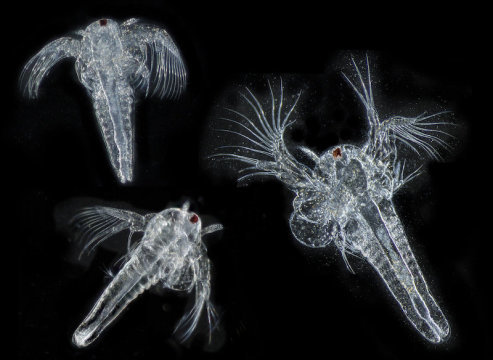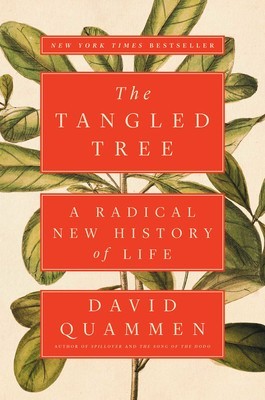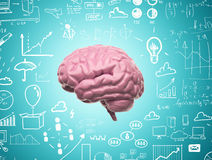Michael J. Behe's Blog, page 459
July 5, 2019
Researchers: A big change in ocean life occurred in the mid-Jurassic

plankton/© Vera Kuttelvaserova, Adobe Stock
About 170 mya ago. From ScienceDaily:
The ocean as we understand it today was shaped by a global evolutionary regime shift around 170 million years ago, according to new research.
Until that point, the success of organisms living within the marine environment had been strongly controlled by non-biological factors, including ocean chemistry and climate.
However, from the middle of the Jurassic period onwards (some 170 million years ago), biological factors such as predator-prey relationships became increasingly important. …
PhD candidate Kilian Eichenseer, the study’s lead author, explained the impact of calcifying plankton: “Today, huge areas of the ocean floor are covered with the equivalent of chalk, made up of microscopic organisms that rose to dominance in the middle of the Jurassic period. The chalky mass helps to balance out the acidity of the ocean and, with that balance in place, organisms are less at the mercy of short-term perturbations of ocean chemistry than they might have been previously. It is easier to secrete a shell, regardless of its mineralogy, if the ocean chemistry is stable.” …
The results show that up until the middle of the Jurassic period, around 170 million years ago, the ecological success of shell-secreting marine organisms was tightly coupled to their shell composition: organisms that secreted the mineral that was environmentally favoured had an evolutionary advantage.
However, the Earth-Life system was revolutionised forever by the rise of calcifying plankton, which expanded the production of calcium carbonate from continental shelves to the open ocean.
This ensured that the evolutionary impact of episodes of severe climate changes, and resulting ocean acidification, was less severe than comparable events earlier in Earth history. Paper. paywall – Kilian Eichenseer, Uwe Balthasar, Christopher W. Smart, Julian Stander, Kristian A. Haaga, Wolfgang Kiessling. Jurassic shift from abiotic to biotic control on marine ecological success. Nature Geoscience, 2019; DOI: 10.1038/s41561-019-0392-9 More.
It would be an interesting thought experiment to consider what the oceans would be like if the formation of shells was difficult. It’s still hard to picture the idea that predation wasn’t as important as dissolution.
See also: Many Plankton Behave Like Both Plants And Animals, Challenging Biological Concepts
Copyright © 2019 Uncommon Descent . This Feed is for personal non-commercial use only. If you are not reading this material in your news aggregator, the site you are looking at is guilty of copyright infringement UNLESS EXPLICIT PERMISSION OTHERWISE HAS BEEN GIVEN. Please contact legal@uncommondescent.com so we can take legal action immediately.
Plugin by Taragana
Origin of life has not been explained
World famous chemistJames Tour explains:
See also: The Science Fictions series at your fingertips – origin of life What we do and don’t know about the origin of life.
Follow UD News at Twitter!
Copyright © 2019 Uncommon Descent . This Feed is for personal non-commercial use only. If you are not reading this material in your news aggregator, the site you are looking at is guilty of copyright infringement UNLESS EXPLICIT PERMISSION OTHERWISE HAS BEEN GIVEN. Please contact legal@uncommondescent.com so we can take legal action immediately.
Plugin by Taragana
Eric Holloway: How ID can help business

Holloway points out that companies today are awash in information. But which patterns are real? Which are cloud bunnies?
One way business intelligence can address this problem (false positives) is hypothesis testing. The data analyst can generate a figure for the probability that a pattern is real, not imagined. The difficulty is that, for strong guarantees, the patterns must be proposed before they are seen in the data. But the more the analyst looks at the data to derive a pattern, the more that analyst falls prey to seeing patterns that are not really there. Thus, the need to state all patterns up front is a huge restriction and deadlocks our ability to gain insight from the data.
Welcome to Data Deadlock. Should we just go home now?
Intelligent design theory might help us make new headway in the fields of information theory and statistics. The problem is familiar: how can we be sure that a pattern we see, for example, apparent design in the biological record, is not merely a chance outcome? Intelligent design theory makes the novel proposal that we can derive patterns from the data after the fact while retaining the strong guarantees of hypothesis testing.
Eric Holloway , “How Business Intelligence Can Break the Data Deadlock” at Mind Matters News
ID theory, he says, offers a way around false positives.
See also: Does information theory support design in nature William Dembski makes a convincing case, using accepted information theory principles relevant to computer science
Follow UD News at Twitter!
Copyright © 2019 Uncommon Descent . This Feed is for personal non-commercial use only. If you are not reading this material in your news aggregator, the site you are looking at is guilty of copyright infringement UNLESS EXPLICIT PERMISSION OTHERWISE HAS BEEN GIVEN. Please contact legal@uncommondescent.com so we can take legal action immediately.
Plugin by Taragana
Mirror universe: Now some media market science fiction as science news
 courtesy Suh-Yeon Choi at Unsplash
courtesy Suh-Yeon Choi at UnsplashThis can’t be because there isn’t real news out there:
Could 2019 be the year humans open the first portal to a shadowy dimension which mirrors our own world?
Scientists in Oak Ridge National Laboratory in eastern Tennessee hope so, and have completed building equipment they are to test this summer which may allow us the first glimpse of a parallel universe which could be identical in many ways to our own, with mirror particles, mirror planets and possibly even mirror life.
That is according to Leah Broussard, the physicist behind the project, who described the attempt to reveal a hidden shadow world as “pretty wacky” in an interview with NBC last week.
The discovery of a concealed mirror world may sound like science fiction from the Stranger Things series, but it has been repeatedly suggested by physicists as a tempting means of explaining anomalous results. However, as yet, hard evidence such a realm exists has refused to manifest itself.
Harry Coburn, “Scientists attempting to open portal to a parallel universe” at MSN
Can’t think why it “has refused” to manifest itself. It’s just so obvious, right?
Hat tip: Ken Francis, co-author with Theodore Dalrymple of The Terror of Existence: From Ecclesiastes to Theatre of the Absurd
Your parallel universes fix for the weekend: Physicists: A mirror universe might explain dark matter
New Scientist has seen signs of a mirror universe touching our own Broussard is about to do tests to find out if it is true. That’s fun, of course, but in reality, no one can prove it false and it will therefore always be real when cosmologists need it. It would be still more fun to see Sabine Hossenfelder tackle this one.
Did Stephen Hawking Discover A Means Of Detecting Parallel Universes Just Before He Died?
That sounds a lot like grief talking but we’ll see.
Claim: Evidence, maybe, for parallel universes
Cosmologist: Parallel Universes Are Pushing Physics Too Far?
Alternate parallel universe found. Maybe (2015)
Test parallel universes for real?
Parallel universes TESTED?
Brit mid-market tabloid says Large Hadron Collider within days of discovering parallel universe
Scientific American tells us we may live in the past of a parallel universe
and why this is supposed to be science.
Copyright © 2019 Uncommon Descent . This Feed is for personal non-commercial use only. If you are not reading this material in your news aggregator, the site you are looking at is guilty of copyright infringement UNLESS EXPLICIT PERMISSION OTHERWISE HAS BEEN GIVEN. Please contact legal@uncommondescent.com so we can take legal action immediately.
Plugin by Taragana
July 4, 2019
The incorrect insect egg model relied too much on model organisms
Just now, we mentioned, at Nature: Researcher smashes conventional evolution doctrine about insect egg shapes. He sees that part of the problem with the old theory was the relative ease of working with model organisms:
 from Placazoan Ponderings
from Placazoan PonderingsMikael Krauze, whose blog is Placazoan Ponderings, explains about the model organisms:
… an overreliance on them leads one to underestimate the complexity of early life forms.
Model organisms are chosen for how easy they are to handle, how fast they reproduce, and how well they manage laboratory conditions. If you need 500 mammals for an experiment, it goes without saying that using mice is much easier than using elephants.
The problem is that organisms that are fast reproducers are prone to experience streamlining selection and reductive evolution. The less stuff an organism has, the faster it can complete the development from single cell to adult.
So the organisms we have chosen to represent invertebrates, like C. elegans and D. melanogaster, are simpler than the average invertebrate. And this means that we’re likely underestimating the complexity of the last common ancestor of animals (Metazoa), as any gene found exclusively in vertebrates is thought to be a vertebrate innovation.
Attempts to correct for this bias has found that the last common Metazoan ancestor was surprisingly complex, seemingly ‘overdesigned’ for its simple morphology:
“A significant proportion of mammalian genes are not represented in the genomes of Drosophila, Caenorhabditis or Saccharomyces, and many of these are assumed to have been vertebrate innovations. To test this assumption, we conducted a preliminary EST project on the anthozoan cnidarian, Acropora millepora, a basal metazoan. More than 10% of the Acropora ESTs with strong metazoan matches to the databases had clear human homologs but were not represented in the Drosophila or Caenorhabditis genomes; this category includes a surprising diversity of transcription factors and metabolic proteins that were previously assumed to be restricted to vertebrates. Consistent with higher rates of divergence in the model invertebrates, three-way comparisons show that most Acropora ESTs match human sequences much more strongly than they do any Drosophila or Caenorhabditis sequence. Gene loss has thus been much more extensive in the model invertebrate lineages than previously assumed and, as a consequence, some genes formerly thought to be vertebrate inventions must have been present in the common metazoan ancestor. The complexity of the Acropora genome is paradoxical, given that this organism contains apparently few tissue types and the simplest extant nervous system consisting of a morphologically homogeneous nerve net.”
—
Kortschak R.D., et al., “EST Analysis of the Cnidarian Acropora millepora Reveals Extensive Gene Loss and Rapid Sequence Divergence in the Model Invertebrates”, Current Biology 13(24 ):2190-2195 (2003)
See also: At Nature: Researcher smashes conventional evolution doctrine about insect egg shapes The new findings almost put the egg in charge of its own shape, not what anyone expected to hear.
Follow UD News at Twitter!
Copyright © 2019 Uncommon Descent . This Feed is for personal non-commercial use only. If you are not reading this material in your news aggregator, the site you are looking at is guilty of copyright infringement UNLESS EXPLICIT PERMISSION OTHERWISE HAS BEEN GIVEN. Please contact legal@uncommondescent.com so we can take legal action immediately.
Plugin by Taragana
At Nature: Researcher smashes conventional evolution doctrine about insect egg shapes
She has cracked a long-standing conundrum about insect eggs.
Whereas most researchers work with only a handful of well-studied animals, such as fruit flies and mice, Extavour’s success comes from her penchant for less-ubiquitous lab critters, such as sand fleas and crickets. Typical model organisms harbour just a fraction of the diversity found in nature, so alongside the usual suspects, she examines a wide range of animals that help to reveal which genetic tools evolution most commonly uses.…
The researchers looked for connections between egg shapes and sizes and many insect features, including where the insects lay their eggs and the time it takes for a fertilized egg to turn into a larva. The analysis revealed a surprise: the evolution of egg shape and size depends largely on where the eggs are laid. Eggs laid in water are often small and spherical; those deposited into the body of another animal are also small, but tend to be oddly shaped.
The findings challenge old assumptions that relate egg size to adult body size, says Laura Lavine, an insect physiologist and evolutionary biologist at Washington State University in Pullman. Many scientists assumed that those size relations were the “end of the story”, Lavine says. “Now the story starts from this study,” she says. Understanding how eggs change depending on the environment could reveal some of the major constraints on how animals grow and evolve, Lavine says.
Giorgia Guglielmi, “The biologist using insect eggs to overturn evolutionary doctrine” at Nature
Studies of eggs from nearly 7000 insect species, showed that no traditional theory about what governs egg size held water:
“The eggs reflect the local ecological conditions that the eggs themselves are living in, much more than anything about the other life stages,” Woods says.
Thus, earlier ideas explaining egg size and shape based on their correlations to traits like developmental time and adult size appear to be incorrect. Big adults don’t always come from big eggs; nor does egg size correlate with development time. Insects have life cycles with four life stages (egg, larva, pupa, adult), each with its own ecology, and each is subject to different selective pressures, Woods explains. “Their data support the idea that the stages may be less connected to one another than we thought, and that shows up in the data as the evolution of the egg stage in relation to its own proximate environments rather than in relation to other stuff happening in other parts of the life cycle. That’s just super cool,” Woods says.
Viviane Callier, “Ecology, Not Physics, Explains Diversity of Insect Eggs” at The Scientist
The new findings almost put the egg in charge of its own shape, not what anyone expected to hear. But also note this:
One of the key things Extavour says was critical in their analysis was to take the phylogenetic relationships of the insects into account using sophisticated statistical methods, because otherwise one could be led to incorrect conclusions. For instance, many beetles tend to have round eggs, so similarities between beetle species are explained by their evolutionary relatedness, not ecology. Only because the researchers chose features such as endoparasitism and aquatic egg laying, which have evolved independently many times, and because they had complete information about the insect evolutionary tree that allowed them to control for the relatedness, were they able to find the pattern that the egg’s environment predicted its size and shape.
Viviane Callier, “Ecology, Not Physics, Explains Diversity of Insect Eggs” at The Scientist
Darwinians don’t like ecology much but they had better get used to it.
Is Extavour the new Lynn Margulis?
See also: Darwinism is taking a beating in the Anthropocene It gets really interesting when the anti-Darwinists are not creationists but fronting various neglected ideas like epigenetics. Will they be more vicious?
Copyright © 2019 Uncommon Descent . This Feed is for personal non-commercial use only. If you are not reading this material in your news aggregator, the site you are looking at is guilty of copyright infringement UNLESS EXPLICIT PERMISSION OTHERWISE HAS BEEN GIVEN. Please contact legal@uncommondescent.com so we can take legal action immediately.
Plugin by Taragana
It makes no sense that octopuses should be so smart
New findings show, the brainy seafood breaks all the rules about why some life forms are smart:
A 2018 study (open access) sought to discover why octopuses are unusually intelligent—and this year another study disputed the findings. The issue is thorny because octopuses obey none of the rules for animal intelligence. Intelligent animals are supposed to be social animals that live a long time. That makes sense; managing relationships requires some intelligence and brains take a long time to mature. As Ed Yong notes in The Atlantic, apes, elephants, whales and dolphins, crows and other corvids, and parrots (all vertebrates) share these traits. But the intelligent octopus shares the physical traits of the “dim-witted dynasty” of snails, slugs, clams, oysters, and mussels that are its own relatives. And it breaks the behavior rules:
With rare exceptions, most of them are solitary animals that aren’t above cannibalizing one another when they meet. Even those that swim in groups, like some squid, don’t form the kinds of deep social bonds that chimps or dolphins do. Cephalopods also tend to live fast and die young. Most have life spans shorter than two years, and many die after their first bout of sex and reproduction.
Ed Yong, “For Smart Animals, Octopuses Are Very Weird” at The Atlantic
…
One difficulty is that just how a life form comes to evolve “intelligence” is a difficult question. Being intelligent ourselves, we can easily see the advantages of intelligence. But that does not tell us how exactly it is acquired. Not only are there no good theories of human consciousness, there are no good theories about how even an octopus comes to be smarter than we might have expected. And that problem underlies the disagreement between the two groups of researchers. Further research might unearth a wealth of interesting information without shedding much light on that conundrum. One difficulty is that the interpretation of research into animal intelligence is sometimes guided by outdated assumptions. … “Scientists clash over why octopuses are smart” at Mind Matters News
See also: See also: Is the octopus a “second genesis of intelligence”? Can its strange powers provide insights for robotics or the human mind?
Follow UD News at Twitter!
Copyright © 2019 Uncommon Descent . This Feed is for personal non-commercial use only. If you are not reading this material in your news aggregator, the site you are looking at is guilty of copyright infringement UNLESS EXPLICIT PERMISSION OTHERWISE HAS BEEN GIVEN. Please contact legal@uncommondescent.com so we can take legal action immediately.
Plugin by Taragana
Darwinism is taking a beating in the Anthropocene
Anthropocene Magazine, that is. (For all you Under rocks out there, the “Anthropocene” is the era we are said to be living in, dominated by humans, the way the Jurassic was dominated by tyrannosaurs, etc.)

But now, get this:
Darwinian theory is based on the idea that heredity flows vertically, parent to offspring, and that life’s history has branched like a tree. Now we know otherwise: that the ‘tree’ of life isn’t that simple.
David Quammen, “Blurring Life’s Boundaries” at Anthropocene
It gets worse. He goes on to say:
One of the most disorienting results of these developments is a new challenge to the concept of “species.” Biologists have long recognized that the boundaries of one species may blur into another—by the process of hybridism, for instance. And the notion of species is especially insecure in the realm of bacteria and archaea. But the discovery that horizontal gene transfer (HGT) has occurred naturally, many times, even in the lineages of animals and plants, has brought the categorical reality of a species into greater question than ever. That’s even true for us humans—we are composite individuals, mosaics.
It’s not just that—as you may have read in magazine articles—your human body contains at least as many bacterial cells as it does human cells. (This doesn’t even count all the nonbacterial microbes—the virus particles, fungal cells, archaea, and other teeny passengers inhabiting our guts, mouths, nostrils, and other bodily surfaces.) That’s the microbiome. Each of us is an ecosystem.
I’m talking about something else, a bigger and more shocking discovery that has come from the revolution in a field called molecular phylogenetics. (That phrase sounds fancy and technical, but it means merely the use of molecular information, such as DNA or RNA sequences, in discerning how one creature is related to another.) The discovery was that sizeable chunks of the genomes of all kinds of animals, including us, have been acquired by horizontal transfer from bacteria or other alien species.
David Quammen, “Blurring Life’s Boundaries” at Anthropocene
and much more. Where’s Darwin’s caregiver? Should we ring the bell?
Now, David Quammen … That name rings a bell. Oh yes, the author of The Tangled Tree:A Radical New History of Life, about the role of epigenetics.
It gets really interesting when the anti-Darwinists are not creationists. Will they be more vicious?
Follow UD News at Twitter!
See also: Jerry Coyne Continues To Be Unhappy Over David Quammen’s Book On Carl Woese
The real issue, of course, is the way horizontal gene transfer turns Darwin’s fabled Tree of Life into confetti.
See also: Jerry Coyne minimizes the significance of horizontal gene transfer
and
At New York Times: Darwin skeptic Carl Woese “effectively founded a new branch of science”
Copyright © 2019 Uncommon Descent . This Feed is for personal non-commercial use only. If you are not reading this material in your news aggregator, the site you are looking at is guilty of copyright infringement UNLESS EXPLICIT PERMISSION OTHERWISE HAS BEEN GIVEN. Please contact legal@uncommondescent.com so we can take legal action immediately.
Plugin by Taragana
July 3, 2019
Researchers: Bonobos eating swamp greens help explain human brain development
From ScienceDaily:
Observations of bonobos in the Congo basin foraging in swamps for aquatic herbs rich in iodine, a critical nutrient for brain development and higher cognitive abilities, may explain how the nutritional needs of prehistoric humans in the region were met. This is the first report of iodine consumption by a nonhuman primate and it is published in the open access journal BMC Zoology. …
Dr. Hohmann said: “Evolutionary scenarios suggest that major developments of human evolution are associated with living in coastal areas, which offer a diet that triggered brain development in hominins. The results of our study suggest that consumption of aquatic herbs from swamps in forest habitat could have contributed to satisfying the iodine requirements of hominin populations used to diets prevalent in coastal environments.”
He added: “Our report potentially answers the question of how apes obtain iodine from natural food sources, when many populations inhabit areas considered to be iodine deficient. Other apes such as chimpanzees and gorillas have also been observed eating aquatic herbs, which suggests that they could be obtaining essential iodine from these sources.”
The authors caution that without data on the iodine status of wild bonobos, it is difficult to tell how much iodine they absorb, although given the high concentrations in the herbs, it is likely to be substantial. The authors also stress that the iodine concentrations obtained at the field site of LuiKotale may not be reflective of the entire Congo basin. Paper. (open access) – Gottfried Hohmann, Sylvia Ortmann, Thomas Remer, Barbara Fruth. Fishing for iodine: what aquatic foraging by bonobos tells us about human evolution. BMC Zoology, 2019; 4 (1) DOI: 10.1186/s40850-019-0043-z More.
Given how little substance there is to all this, they could at least have included some cute bonobo pix.
Re human brain, you may as well also consider this: Eating fat, not meat, led to bigger human type brains, say researchers. Theories of the evolution of the human brain are a war of trivial explanations that no one dare admit are too trivial for what they purport to explain. It’s like blaming World War II on indigestion, only monstrously bigger.
Earlier discussion of the fat theory.
Starchy food may have aided human brain development
Do big brains matter to human intelligence?
Human evolution: The war of trivial explanations
and
What Taragana
Neurosurgeon Michael Egnor takes on a materialist neurologist

Yale’s Steven Novella of NEUROLOGICAblog, here:
Consider Novella’s two main ideas:
“[This is] the illusion that our brains evolved to have, a very compelling and persistent illusion – namely that the reality we perceive is real, rather than a constructed representation.”
and
“[This research] just slaps us in the face with this reality.”
Novella refutes himself. He first asserts that everything he knows is an illusion. Then he insists that his illusions have slapped him in the face with reality.
Goodness gracious.
If everything we perceive is an illusion, then how can we “know” anything, including such ambitious knowledge as “everything we know is an illusion”?
Novella senses this problem with his thesis and tries to elide it:
Michael Egnor, “Tales of the mind: A neurologist encounters the house of mirrors” at Mind Matters News
We predict fireworks in July. 
Michael J. Behe's Blog
- Michael J. Behe's profile
- 219 followers



